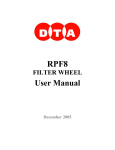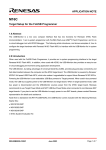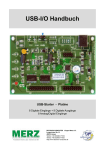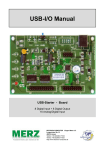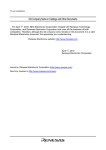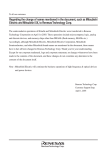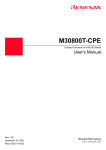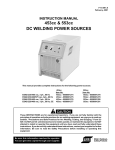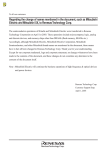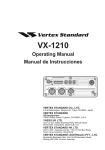Download M16C Flash Start User Manual
Transcript
M16C Flash Start User’s manual MITSUBISHI ELECTRIC SEMICONDUCTOR SYSTEMS CORPORATION Z1-MSA0806.E Rev.C Windows 95 and Windows 98 are registered trademarks of Microsoft Corporation, US. PC/AT is a registered trademark of IBM Corporation, US. Revisions Rev.A Published Sep.1999 Rev.B Published Dec.1999 Rev.C Published Jan.2000 Publisher Notes (1) Copyright. All rights reserved. No part of this document may be reproduced without the express written permission of MITSUBISHI ELECTRIC SEMICONDUCTOR SYSTEMS CORPORATION. (2) The information in this document is subject to change without notice and does not represent a commitment on the part of MITSUBISHI ELECTRIC SEMICONDUCTOR SYSTEMS CORPORATION. (3) Should you notice anything incorrect, strange or missing in this document, contact MITSUBISHI ELECTRIC SEMICONDUCTOR SYSTEMS CORPORATION. (4) MITSUBISHI ELECTRIC SEMICONDUCTOR SYSTEMS CORPORATION shall assume no responsibility whatsoever for troubles arising from the use of this product, regardless of item (3) above. For inquiries MITSUBISHI ELECTRIC SEMICONDUCTOR SYSTEMS CORPORATION ENGINEERING SECTION E ENGINEERING DEPARTMENT A OSAKA SEMICONDUCTOR APPLICATION CENTER FAX: (06) 6338-5193 E-mail: [email protected] - TABLE OF CONTENTS 1 OUTLINE...............................................................................................1 2 STARTUP..............................................................................................3 3 INTERNAL FLASH MEMORY MODE..................................................4 3.1 ID Check ............................................................................................................... 4 3.2 Communications Setup....................................................................................... 5 3.3 Device Command................................................................................................. 6 • Load (ID) ....................................................................................................... 7 • Blank ............................................................................................................. 7 • Read.............................................................................................................. 7 • Status ............................................................................................................ 7 • E.P.R ............................................................................................................. 8 • B.P.R ............................................................................................................. 8 • Program ........................................................................................................ 8 • Erase............................................................................................................. 8 • Setting ........................................................................................................... 8 • Download ...................................................................................................... 8 • Version .......................................................................................................... 8 • Exit ................................................................................................................ 8 4 M16C/80 BOOT LOADER MODE........................................................9 4.1 Selecting a File .................................................................................................... 9 4.2 Communications Setup....................................................................................... 9 4.3 Device Command............................................................................................... 10 • Load ............................................................................................................ 11 • Blank (Note1) .............................................................................................. 11 • Read (Note1)............................................................................................... 11 • Status (Note1) ............................................................................................. 11 • E.P.R (Note1) .............................................................................................. 11 • B.P.R (Note1) .............................................................................................. 11 • Program (Note1).......................................................................................... 11 • Erase (Note1) .............................................................................................. 11 • Setting ......................................................................................................... 11 • Download .................................................................................................... 12 • Version ........................................................................................................ 12 • Exit .............................................................................................................. 12 5 APPENDIX ......................................................................................... 13 5.1 Memory Map....................................................................................................... 13 5.1.1 M30624FGA............................................................................................. 13 5.1.2 M30800FC ............................................................................................... 13 5.1.3 M30220FC ............................................................................................... 14 5.1.4 M30201F6 ................................................................................................ 14 5.1.5 M30802SGP ............................................................................................ 15 5.2 Standard serial I/O Mode ................................................................................... 16 5.2.1 M30800FCFP........................................................................................... 16 5.2.2 M30624FGAFP ........................................................................................ 17 5.2.3 M30220FC ............................................................................................... 18 5.2.4 M30220FC ............................................................................................... 19 5.3 About the ID Check............................................................................................ 20 5.4 Messages ........................................................................................................... 22 5.5 Example of Target Board Circuit ...................................................................... 23 5.5.1 Using High-speed Serial Cable ................................................................ 23 5.5.2 Using RS-232C Cable .............................................................................. 24 M16C Flash Start 1 Outline M16C Flash Start (FlashSta.exe) is the software to operate on M16C microcomputers that contain internal flash memory or those which have external M16C/80 ROM from an Windows version personal computer (PC/AT). It has two modes of operation: • Internal Flash Memory Mode In this mode, the software operates on an M16C microcomputer that contains internal flash memory to program or erase its internal flash memory. • M16C/80 Boot Loader Mode It allows you to download into the internal RAM of a microcomputer which comes with external M16C/80 ROM, as well as program and erase the external flash memory (limited to only M5M29T160BVP) mounted on the target system. If you want to operate on external flash memory other than M5M29T160BVP, please prepare a control program suitable for the flash memory you are using and transfer it into the internal RAM of the microcomputer using the download function. The following shows the operating environment for M16C Flash Start. (1) IBM PC/AT-compatible computer running Windows 95 or later (2) 1 serial port M16C Flash Start requires an RS-232C serial communications cable and a voltage converter circuit that can convert voltage to the cable's output level. (Refer to Section 5.5, "Example of Target Board Circuit" on page 23.) 1 M16C Flash Start The table below shows the supported types of microcomputers and how to set the related pins required for writing data. Table 1. Pin Settings Internal Flash MCU Type Boot Loader Function M16C/62A M16C/80 M16C/22 M16C/20 M30802SGP BUSY(RTS1) Open - - Open CLK1 “L” input - - “L” input RxD1 PC TxD - - PC TxD TxD1 PC RxD - - PC RxD - Open - - - - “L” input - - “L” input - - - - Vcc input - Serial data output Operation monitoring pin Switch to M16C Flash Start Switch to M16C Flash Start Mode entry RxD0 - PC TxD PC TxD - Serial data input TxD0 - PC RxD PC RxD - Serial data output CNVss Vcc input Vpp input (*2) Vpp input (*2) “L” input Mode entry CE(*1) Vcc input - - - Mode entry EPM(*1) “L” input Reset input Reset input Reset input Mode entry RESET Reset input Reset input Vcc Vcc Vcc Vcc Vcc Power input Vss GND GND GND GND GND Pin Name BUSY(RTS0) CLK0 Operation monitoring pin Switch to M16C Flash Start Serial data input *1: Refer to "5.2 Standard serial I/O Mode" on page 16 for pin assign. *2: Refer to flash microcomputer datasheets. M16C Flash Start can communicate with the target microcomputer in the range of main clock input oscillation frequencies shown below. 2 MHz to the maximum input oscillation frequency 2 M16C Flash Start 2 Startup Execute M16C Flash Start (FlashSta.exe), and the environment setup screen shown below will appear. Use this screen to choose program mode and serial port (COM1-4). After selecting the above, go to each program mode. Figure 1. Environment Setup Screen When select "OK" button, it will take a few seconds untill next screen appears. 3 M16C Flash Start 3 Internal Flash Memory Mode The following explains how to operate in internal flash memory mode. 3.1 ID Check After selecting program mode, an ID Check dialog box is displayed. From this dialog box, choose the program file to be operated on, enter ID code, and choose the type of MCU used. Figure 2. ID Check Dialog Box Input the file name in the File Path field box and the ID code in the ID field box. Clicking on the [Refer…] button will display file names for your referral and selection. If the ID file is in the same folder (Refer to Section 5.3, "About the ID Check" on page 20), the ID code is loaded when the file is selected. If the microcomputer is a blank product, you do not need to enter ID. Files in only Motorola S2 format can be selected. Files in any other formats cannot be selected. The ID code you need to enter is the code currently written in flash memory. After referencing files, choose the MCU Type. Clicking on the [OK] button will start the ID check. After the check, the M16C Flash Start window will open up, from where device commands can be executed. If an ID matching error occurs, the M16C Flash Start window will open up just the same, but it will be preceded by an error message and the commands will be inoperable. In such case, recheck your ID code. Clicking on the [Cancel] button will open the M16C Flash Start window without running an ID check. With the M16C Flash Microcomputer, device commands can be used with blank ROMs - that is to say without performing an ID check. If communication with the microcomputer results in an error, reset the target system following the messages and then set up communication back again. 4 M16C Flash Start 3.2 Communications Setup From the Set baudrate dialog box, set the rate with which to communicate with the microcomputer and the time interval at which to send data. Figure 3. Communications Setup Set a communication rate for Baud rate (bps). At the M16C Flash Start startup, communication status is set at 9600 bps. After that, the previously set baud rate is used. Before exiting the programmer, return MCU communications to 9600 bps. Baud rate can be selected from the below speeds. 9600, 19200, 38400, 57600, *115200 (bps) *115200 bps is supported for only M16C/80. Depending on the microcomputer's main clock input oscillation frequency or MCU type, the selected baud rate may result in communication error. In such a case, choose another baud rate. Table 2. Communicable Baud Rates at Each Frequency (Reference) Baud rate (bps) Xin(MHz) 9600 19200 38400 57600 115200 20 O O O O O 16 O O O O 10 O O X O 8 O O O O 6 O O O X 4 O O X X 3 O O O X 2 O X X X O: Communicable X: Not communicable For Program_intervals (ms), set a time interval from one page of data transferred to the next page of data transferred when executing program commands. As you change the time interval, the program commands execution time changes. The time interval is set to 40 ms when the program starts. It can be selected from the values listed below. 5 ms to 50 ms; at intervals of 5 ms 5 M16C Flash Start Depending on the microcomputer's operating frequency or MCU type, the time in which data is written to flash memory varies. If a communication error occurs when executing program commands, increase the time interval. 3.3 Device Command The Device command dialog box is for executing device commands. Figure 4. Device Command Dialog Box If the flash ROM is blank, the device commands can be used even without running an ID check. With written ROMs, until the ID check is run and completed, only the [Load (ID)], [Status], [Setting] and [Version] commands can be used. When the [Program] and other commands are selected, the Input Address dialog box opens up. Enter the address range to be operated on by the command. The default address input values are the upper-limit and lower-limit addresses in the file that was specified during ID check. (When no file is selected, the start and end addresses of M16C/62A flash memory are assumed.) Input an address within the setting range. (Refer to Section 5.1, "Memory Map" on page 13.) Figure 5. Input Address Dialog Box 6 M16C Flash Start • Load (ID) Refer to Section 3.1, "ID Check" on page 4. • Blank Checks internal flash memory for blank. • Read Compares the program file specified for Load (ID) with the content written in flash memory. • Status Displays the status of the flash memory. Figure 6. Status Display Screen The table below lists the content of each item. Table 3. Contents of Status Item 1 Write state machine status 2 ID check 3 Erase 4 Program After block 5 6 Check sum 7 Data receive timeout Content of Processing Shows operating status of flash memory. [Ready] : Program/erase ready [Busy] : Program/erase in progress Shows ID check status of flash memory. [Not Yet] : Not verified [Not match] : Verification mismatch [Match] : Verified Shows erase status of flash memory. [Error] : Terminated in error [Right] : Terminated normally Shows programming status of flash memory. [Error] : Terminated in error [Right] : Terminated normally Shows excessive write status when writing pages. [Error] : Excessively written [Right] : No excessive write Shows boot program transfer result. [Match] : Checksum matched [Not Match] : Checksum mismatched Shows time-out occurrence status when receiving data. [Time Out] : Time-out occurred when receiving [Right] : Received data normally 7 M16C Flash Start • E.P.R Sequentially executes erase, program, and read commands. • B.P.R Sequentially executes blank, program, and read commands. • Program Writes the program file specified for Load (ID) into flash memory. • Erase Unlocks each block of flash memory and then erases the entire area of flash memory. • Setting Refer to Section 3.2, "Communications Setup" on page 5. • Download Upgrades the control program version. The updating control program specified for Load (ID) is downloaded into the internal RAM of the microcomputer. When the download is completed, the program transferred into the internal RAM starts operating. • Version Outputs version information on the microcomputer's control program. Figure 7. Version Information • Exit Changes the communication rate to 9600 bps before quitting M16C Flash Start. 8 M16C Flash Start 4 M16C/80 Boot Loader Mode This section explains how to use M16C/80 boot loader. 4.1 Selecting a File After selecting program mode, a Program/Download File Select dialog box is displayed. Enter the file name to be downloaded into the internal RAM or with which to program external flash memory. Figure 8. Selecting a File Input the file name in the File Path field box. Clicking on the [Refer…] button will display file names for your referral and selection. Files in only Motorola S2 format can be selected. Files in any other formats cannot be selected. Click on [OK] button, and a device command dialog box will appear after completing file selection. When you click on [Cancel] button, a device command dialog box is displayed after canceling file selection. If communication with the microcomputer results in an error, reset the target system following the messages and then set up communication back again. 4.2 Communications Setup Refer to Section 3.2, "Communications Setup" on page 5. 9 M16C Flash Start 4.3 Device Command From the Device command dialog box, execute device commands to download files into the internal RAM, program external flash memory, etc. Figure 9. Device Command Dialog Box When the [Program] and other commands are selected, the Input Address dialog box opens up. Enter the address range to be operated on by the command. The default address input values are the upper-limit and lower-limit addresses in the file that was specified during ID check. (When no file is selected, the start and end addresses of M16C/62 flash memory are assumed.) Enter addresses within the range in which external flash memory is located. (Refer to Section 5.1.5, " M30802SGP" on page 15.) Figure 10. Input Address Dialog Box 10 M16C Flash Start • Load Refer to Section 4.1, "Selecting a File" on page 9. • Blank (Note1) Checks external flash memory for blank. • Read (Note1) Compares the program file specified for Load (ID) with the content written in external flash memory. • Status (Note1) Displays the status of the external flash memory(the M5M29T160BVP). (Refer to Section 3.3, "Status" on page 6.) • E.P.R (Note1) Sequentially executes erase, program, and read commands for external flash memory. • B.P.R (Note1) Sequentially executes blank, program, and read commands for external flash memory. • Program (Note1) Writes the program file specified for Load (ID) into flash memory. • Erase (Note1) Erases the entire area of external flash memory. However, blocks in locked state whose lock bit = 0 are not erased. • Setting Refer to Section 3.2, "Communications Setup" on page 5. (Note1) Please do not use this command except when connect specified external flash memory. 11 M16C Flash Start • Download Transfers the file selected in Section 4.1, "Selecting a File," into the internal RAM of the microcomputer. When the download is completed, the program transferred into the internal RAM starts operating. When creating a downloading program, be sure to set a version number (eight characters) at the beginning of the program. Also, set address 000600h for the start address of the program, and make sure the program size is within the downloadable area (000600h to 0029FFh). [Example of downloading program] ; ********************************************************************** ; M16C/80 Flash Micon Test Program. * ; CPU : M16C/80 (Xin=20.0MHZ) * ; FUNCTION : Port2 Rotate Output Test. * ; CODED BY : (Mr.Sawa)1999-05-11 * ; ********************************************************************** ;------ Include Defined. ----------------------------------------------.LIST OFF .INCLUDE SFR80.INC .LIST ON ;------ Symbol Defined. -----------------------------------------------VSTACK . EQU VRAM . EQU VPRO . EQU 0002B00H; Stack-Point (ISP) 0000400H ; Internal RAM Area (0000400H - 00005FFH) 0000600H ; Download Program Area (0000600H– 00029FFH) . SECTION . ORG VRAM RAMDATA, DATA . SECTION . ORG VPRO PROGRAM, CODE RESET: . byte "VER.0.05" ; Set Firmware VersionNO. mov.b mov.b #0ffh, #001h, mov.w sbjnz.w #0FFFFh, R0 #1,R0,?- ; Wait rot.b jmp #1, LOOP ; Rotate P2 ; Loop PD2 P2 LOOP: ?: P2 .END • Version Outputs version information on the microcomputer's control program. • Exit Changes the communication rate to 9600 bps before quitting M16C Flash Start. 12 M16C Flash Start 5 Appendix 5.1 Memory Map 5.1.1 M30624FGA 0C_0000h Block 6: 64 Kbytes 0D_0000h Block 5: 64 Kbytes 0E_0000h Block 4: 64 Kbytes 0F_0000h Block 3: 32 Kbytes 0F_8000h Block 2: 8 Kbytes 0F_A000h Block 1: 8 Kbytes 0F_C000h Block 0: 16 Kbytes 0F_FFFFh 5.1.2 M30800FC FE_0000h Block 4: 64 Kbytes FF_0000h Block 3: 32 Kbytes FF_8000h Block 2: 8 Kbytes FF_A000h Block 1: 8 Kbytes FF_C000h Block 0: 16 Kbytes FF_FFFFh 13 M16C Flash Start 5.1.3 5.1.4 M30220FC 0E_0000h Block 1: 32 Kbytes 0E_8000h Block 2: 32 Kbytes 0F_0000h Block 3: 32 Kbytes 0f_8000h Block 4: 32 Kbytes M30201F6 0F_0000h 48 Kbytes 0F_FFFFh 14 M16C Flash Start 5.1.5 M30802SGP The diagram below shows the area that can be downloaded into M16C/80 flash microcomputers using this program. 000000h SFR area 0003FFh 000400h 0005FFh 000600h Internal RAM area 0029FFh 002A00h Downloadable area (9K bytes) 002BFFh 002C00h 007FFFh 008000h Internal reserved area External area (*) External flash memory connectable area FFFFFFh (*) For details about memory mapping, refer to M16C/80 datasheets. . 15 M16C Flash Start 5.2 Standard serial I/O Mode 5.2.1 M30800FCFP 81 82 83 84 85 86 87 88 P0 7 /D 7 P0 6 /D 6 P0 5 /D 5 P0 4 /D 4 P0 3 /D 3 P0 2 /D 2 P0 1 /D 1 89 90 91 92 P0 0 /D 0 P1 07 / AN 7 / KI3 P1 06 / AN 6 / KI2 P1 05 / AN 5 / KI1 93 94 95 96 97 8 80 79 7 8 7 7 76 75 74 73 72 71 7 0 6 9 6 8 6 7 66 65 6 4 63 62 61 6 0 5 9 58 5 7 56 55 54 53 52 51 3 BYTE CN Vss P8 7 /X CIN P 8 6 / X CO U T R ES ET 98 P9 4 /D A 1 /TB4 IN /C TS 4 /RT S 4 /SS 4 P9 3 /D A 0 /TB 3 IN /C TS 3 / RT S 3 /SS 3 P9 2 /TB2 IN /T X D 3 / SDA 3 / SRxD 3 P9 1 /T B1IN /R X D 3 /SC L 3 /STxD 3 P9 0 /T B0 IN/ CL K 3 2 P7 6 /TA3 O U T P7 5 /T A2I N/ W P7 4 /T A2O U T/ W P7 3 /C TS 2 /R TS 2 / TA 1 IN /V P7 2 /C LK 2 / TA1 O UT /V P7 1 /R xD 2 /SC L 2 /TA0 IN /TB 5 IN P70 / T X D 2 /SD A 2 /TA 0 O U T 9 10 1 1 1 2 1 3 1 4 15 16 1 7 1 8 19 20 21 22 23 24 2 5 2 6 2 7 28 29 30 P 8 0 /TA4 O U T/U P7 7/TA 3 IN 7 P 84 /IN T 2 P83 / IN T1 P 82 /IN T 0 P8 1 /TA4 IN/U 6 V SS X IN VCC P8 5 /N M I 5 XOU T 4 Co nnec t circu it os cilla tio n R ESET P9 6/ ANEX 1/T X D 4 / SDA 4 / SRxD 4 P9 5 /AN EX0/ CL K 4 1 C N Vss Vcc P104 /AN 4/ KI0 P10 3 /AN 3 P10 2 /AN 2 P10 1 /AN 1 AV SS CE Vss Vss >> Vcc 99 R ESET P10 0 /AN 0 VRE F AVc c EPM Va lu e Vcc 100 C NVss P9 7 /A D TRG / RX D 4 /SC L 4 /STxD 4 M o de se tt ing S ign a l M 16C /8 0(10 0-p in ) Gr ou p F las h M em o ry V ers io n (100 P 6S ) 50 49 P4 4 /C S3/ A20 (M A12) P4 5 /C S2/A 21 P5 0 /W R L /WR/C AS L P4 6 /C S1/A 22 P4 7 /C S0/A 23 48 47 P5 1 /W R H /BH E/CASH P5 2 /R D/DW P5 3 /BC LK/ ALE/CLK OU T P5 4 /H LD A/AL E P5 5 /H OLD P5 6 /AL E/R AS P5 7 /R DY P6 0 /C TS 0/R TS 0 P6 1 /CLK 0 P6 2 /R xD 0 P6 3 /TXD 0 P6 4 /C TS 1 /R TS 1/CT S 0 /C LKS 1 P6 5 /CLK 1 P6 6 /RxD 1 P6 7 /T XD 1 46 45 44 43 42 41 40 39 38 37 36 35 34 33 32 31 CE EPM BUSY RxD Vss Vcc SC L K TxD Figure 11. Pin Connections for Serial I/O Mode (1) 16 P1 0/D 8 P1 1/D 9 P1 2/D 10 P1 3/D 11 P1 4/D 12 P1 5/D 13 /IN T3 P1 6/D 14 /IN T4 P1 7/D 15 /IN T5 P2 0/A 0 (/D 0 ) P2 1/A 1 (/D 1 ) P2 2/A 2 (/D 2 ) P2 3/A 3 (/D 3 ) P2 4/A 4 (/D 4 ) P2 5/A 5 (/D 5 ) P2 6/A 6 (/D 6 ) P2 7/A 7 (/D 7 ) Vss P3 0/A 8 (M A0 )(/D 8 ) Vcc P3 1/A 9 (M A1 )(/D 9 ) P3 2/A 10 (M A2 )(/D 10 ) P3 3/A 11 (M A3 )(/D 11 ) P3 4/A 12 (M A4 )(/D 12 ) P3 5/A 13 (M A5 )(/D 13 ) P3 6/A 14 (M A6 )(/D 14 ) P3 7/A 15 (M A7 )(/D 15 ) P4 0/A 16 (M A8 ) P4 1/A 17 (M A9 ) P4 2/A 18 (M A1 0) P4 3/A 19 (M A1 1) M16C Flash Start 5.2.2 M30624FGAFP CE P0 7/D 7 P0 6/D6 P0 5/D5 P0 4/D 4 P0 3/D3 P0 2/D 2 P0 1/D 1 P0 0/D0 P107/AN7/KI3 P106/AN6/KI2 P105/AN5/KI1 P104/AN4/ KI0 P10 3/AN 3 P10 2/AN 2 P10 1/AN 1 AVSS P10 0/AN 0 VRE F AVcc P9 7/ADTRG/S IN4 Mode setup method Value Signal CNVss Vcc EPM Vss RESET Vss to Vcc Vcc 81 82 83 84 85 86 87 88 89 90 91 92 93 94 95 96 97 2 3 4 5 6 7 8 9 10 11 12 13 14 15 16 17 18 19 20 21 22 23 24 25 26 27 28 29 30 Connect oscillator circuit. 80 79 78 77 76 75 74 73 72 71 70 69 68 67 66 65 64 63 62 61 60 59 58 57 56 55 54 53 52 51 1 RESET 98 99 100 CNVss P96/ANEX1/SOUT4 P9 5/ANEX0/CLK4 P94/DA1/TB4 IN P93/DA0/TB3 IN P92/TB2 IN/SOUT3 P91/TB1 IN/SIN3 P90/TB0 IN/CLK3 BYTE CNVss P8 7/XCIN P8 6/X COUT RESET X OUT VSS XIN VCC P8 5/NMI P84/INT2 P83/INT1 P82/INT0 P8 1/TA4 IN/U P8 0/TA4OUT/U P7 7/TA3IN P76/TA3 OUT P7 5/TA2IN/W P74/TA2OUT/W P7 3/CTS 2/RTS2/TA1 IN /V P7 2/CLK2/TA1 OUT /V P71/RxD 2/SCL/TA0IN /TB5 IN P70/TXD 2/SDA/TA0 OUT M1 6C/6 2A fla sh me mor y ve rsi o n (100 P6S) 50 49 48 47 46 45 44 43 42 41 40 39 38 37 36 35 34 33 32 31 P4 4/CS0 P4 5/CS1 P4 6/CS2 P4 7/CS3 P50/WRL/WR P51/WRH/BHE P52/RD P53/BCLK P5 4/HLDA P5 5/HOLD P56/ALE P5 7/RDY/CLKOUT P60/CTS0/RTS0 P6 1/CLK0 P6 2/RxD0 P6 3/TXD 0 P6 4/CTS1/RTS1/CTS0/CLKS1 P6 5/CLK1 P66/RxD1 P67/TXD 1 CE EPM BUSY RxD Vss Vcc SCLK TxD Figure 12. Pin Connections for Serial I/O Mode (2) 17 P10/D 8 P11/D 9 P12/D 10 P13/D 11 P14/D 12 P15/D 13/INT3 P16/D 14/INT4 P17/D 15/INT5 P2 0/A0(/D 0/-) P2 1/A1(/D 1/D0) P2 2/A2(/D 2/D1) P2 3/A3(/D 3/D2) P2 4/A4(/D 4/D3) P2 5/A5(/D 5/D4) P26/A6(/D6/D 5) P27/A7(/D7/D 6) Vss P30/A8(/-/D7) Vcc P31/A9 P3 2/A10 P3 3/A11 P3 4/A12 P3 5/A13 P3 6/A14 P3 7/A15 P4 0/A16 P4 1/A17 P4 2/A18 P4 3/A19 M16C Flash Start M30220FC 74 73 75 76 77 79 78 80 81 83 82 84 85 86 88 87 89 90 91 93 92 94 95 97 96 98 100 99 102 101 103 104 106 105 110 72 71 111 70 112 113 69 114 67 66 109 68 115 116 117 65 118 63 62 64 119 120 121 61 122 59 58 60 123 57 124 125 M30220 flash memory version (144P6Q-A, 144PFB-A) 126 127 128 129 56 55 54 53 52 130 51 131 50 49 132 133 48 134 47 135 46 45 136 137 44 138 43 139 42 41 140 141 40 142 39 143 38 37 TxD CE No te1 RESET No te2 VPP Mode setup method Signal CNVss RESET CE Value 4.5V to 5.5V Vss Vcc Vcc Note 1: Connect oscillator ci rcui t. Note 2: Connect to V CC when V CC = 4.5V to 5.5 V. Connect to Vpp (=4.5V to 5.5 V) when V CC = 2.7V to 4.5 V. Figure 13. Pin Connections for Serial I/O Mode (3) 18 BUSY RxD SCLK 36 35 34 32 33 31 30 29 27 28 26 25 23 24 22 21 20 18 19 17 16 14 15 13 12 11 9 10 8 7 5 6 4 3 P1 5/KI5 P1 6/KI6 P1 7/KI7 P2 0/KI8 P2 1/KI9 P2 2/KI1 0 P2 3/KI1 1 P2 4/KI1 2 P2 5/KI1 3 P2 6/KI1 4 P2 7/KI1 5 P3 0/KI1 6 P3 1/KI1 7 P3 2/KI1 8 P3 3/KI1 9 P3 4 P3 5 P4 0/TA0OUT P4 1/TA0IN P4 2/TA1OUT P4 3/TA1IN P4 4/TA2OUT P4 5/TA2IN P4 6/TA3OUT/INT4 P4 7/TA3IN /INT4 P5 0/TB0IN P5 1/TB1IN P5 2/TB2IN P5 3/TB3IN P5 4/TB4IN P5 5/TB5IN P5 6/INT3 P5 7/CK OU T P60/CTS0/RTS 0 P61/CLK0 P62/RxD0 P9 6/AN6 P9 5/AN5 P94/AN4 P9 3/AN3 P9 2/AN2 P9 1/AN1 P9 0/AN0 P8 7/TA7 IN P86 /TA7OUT P85/TA6IN P84 /TA6OUT P8 3/TA5 IN P82 /TA5OUT P8 1 /TA4IN/INT 5 P80/TA4OUT/INT 5 CNV SS X CIN X COUT RESET XOUT V SS X IN VCC P7 7/NMI P76/INT 2 P75/INT 1 P74/INT 0 P7 3/CTS2 /RTS2 P72/CLK2 P71/RXD2/SCL P70/TXD2/SDA P67/TxD1 P66/RxD1 P65/CLK1 P64 /CTS 1/RTS1/CTS 0/CLKS1 P63/TxD0 2 144 1 SEG 18/P102 SEG 17/P101 SEG 16/P10 0 SEG1 5 SEG14 SEG13 SEG12 SEG1 1 SEG10 SEG 9 SEG8 SEG 7 SEG 6 SEG 5 SEG 4 SEG 3 SEG 2 SEG 1 SEG 0 COM3 COM2 COM1 COM0 C2 C1 VL 3 VL 2 VL1 Vss P13 2/DA 2 P13 1/DA 1 AV SS P130 /ADTRG /DA0 VREF AVCC P97/AN7 107 108 SEG 19/P10 3 SEG 20/P10 4 SEG 21/P10 5 SEG 22/P10 6 SEG 23/P10 7 SEG 24/P11 0 SEG 25/P11 1 SEG 26/P11 2 SEG 27/P11 3 SEG 28/P11 4 SEG 29/P11 5 SEG 30/P11 6 SEG 31/P11 7 SEG 32/P12 0 SEG 33/P12 1 V SS SEG 34/P1 2V2CC SEG 35/P12 3 SEG 36/P12 4 SEG 37/P12 5 SEG 38/P12 6 SEG 39/P12 7 SEG 40/P00 SEG 41/P01 SEG 42/P02 SEG 43/P03 SEG 44/P04 SEG 45/P05 SEG 46/P06 SEG 47/P07 P10/KI0 P11/KI1 P12/KI2 P1 3/KI3 P14/KI4 5.2.3 VCC VSS M16C Flash Start M30201F6 Mode setup method P45/ TX2INOUT P6 6/AN6 P6 1/AN1 P6 2/AN2 P6 3/AN3 P6 4/AN4 P6 5/AN5 P6 0/AN0 AV SS 30 29 P4 2/RXD1 P4 1/TA0OUT P4 0/TA0IN/TXD 1 15 16 P4 4/INT1/TX1INOUT P4 3/INT0/TX0INOUT 9 10 11 12 13 14 26 27 28 VC C VSS XIN VCC M30201F6FP M30201F6TFP P15 (LED 5) P14 (LED 4) VSS 6 7 8 39 38 37 36 35 34 33 32 31 P3 0 P17 (LED 7) P16 (LED 6) N.C. XOUT 42 41 40 P3 3 P3 2 P3 1 RESET P7 1/TB1IN/X CIN P70 /TB0IN/XCOUT RESET 1 2 3 4 5 20 21 22 23 24 25 CNVSS P5 1/RXD 0/AN 51 P5 0/TXD 0/ AN 50 CNVSS N.C. P3 5 P3 4 TXD 17 18 19 R XD 49 48 47 46 45 44 43 N.C. AV CC VREF VSS VCC BUSY VC C SCLK VPPH VSS 56 55 54 53 52 51 50 RESET P5 2/CLK0/AN52 Value CNVSS P5 3/CLKS/AN 53 P5 4/CKOUT/AN54 Signal Connect oscillator circuit. 5.2.4 Figure 13. Pin Connections for Serial I/O Mode (3) 19 P6 7/AN7 N.C. P0 0/KI0 P0 1/KI1 P0 2/KI2 P0 3/KI3 P0 4/KI4 P0 5/KI5 P0 6/KI6 P0 7/KI7 P10 (LED 0) P11 (LED 1) P12 (LED 2) P13 (LED 3) M16C Flash Start 5.3 About the ID Check The ID check compares the ID code stored in the flash ROM against the ID code sent via serial com- munications. Unless the two ID codes match, certain commands are disabled. The table below lists the areas in which ID code is stored. Table 4. ID Address MCU Type M16C/62A M16C/20 M16C/80 ID Address ROM code protect information 0FFFDFh,0FFFE3h,0FFFEBh,0FFFEFh,0FFFF3h,0FFFF7h, 0FFFFBh 0FFFFDFh,0FFFFE3h,0FFFFEBh,0FFFFEFh,0FFFFF3h, 0FFFFF7h,0FFFFFBh 0FFFFFh 0FFFFFFh S2140FFFB0E8C5EEC5F4C5FAC500C606C60CC612C619 S2140FFFC018C61EC624C62AC630C636C63CC642C685 S2100FFFD048C64EC654C65AC660C665C664 S2140FFFDCCDC60F0050C70F00D8C70F00CFC80F00E5 S2140FFFEC13CA0F005BC80F004DCB0F004ECB0F0084 S2080FFFFC18CD0F00F9 S804000000FB Figure 14. Motorola S2 File – ID Address (M16C/62A) By creating an ID file with an ID code and ROM code protect information (ROM protect during parallel writing), the ID code is automatically loaded when your work file is selected in the ID Check dialog box (Refer to Section 3.1, "ID Check" on page 4). The ID file can be created with the -ID option of LMC30 (LMC308). The ROM code protect can be set with the -protect option. LMC30 (LMC308) is included in Mitsubishi's NC30 (NC308) compiler and AS30 (AS308) assembler for M16C and are supported in following versions. LMC30 ; V.3.10.00 LMC308 ; V.1.00.01 It is explained here following how to set IDs, create files and protect data with LMC30. (1) ID Setting • The ID code is set with the -ID option. Only capital letters "ID" are accepted. • Immediately after inputting "-ID", input an ID code as # plus a hexadecimal number or in singlebyte alphabetic characters. • "H" is not needed to indicate the hexadecimal number. • An error occurs if the ID code exceeds 56 bits. 20 M16C Flash Start • To set an ID code as a hexadecimal number, add # after inputting "-ID". Numbered codes can be up to 14 digits long. • To set an ID code in single-byte alphabet input the text string after inputting "-ID". Lettered codes can be up to seven characters long and must be single-byte ASCII code (30h - 39h, 41h - 5Ah and 61h – 7Ah). Example: -ID#1234 The ID is 12340000000000. It is stored as "12h" in address FFFDFh, "34h" in address FFFE3h and "00h" in addresses FFFEBh, FFFEFh, FFFF3h, FFFF7h and FFFFBh. Example: -IDCODE The ID is 434F4445000000. It is stored as "43h" in address FFFDFh, "4Fh" in address FFFE3h, "44h" in address FFFEBh, "45h" in address FFFEFh and "00h" in addresses FFFF3h, FFFF7h and FFFFBh. (2) ID File Output When the -ID option is input, LMC30 creates a file containing the ID code and ROM code protect information (address FFFFFh), and names it with the HEX file (Motorola S2 format) ".id" extension. Example: LMC30 -ID#1234 samp A file with the below contents will be created under the name “samp.id”. -ID1234 FFFDF FFFE3 FFFEB FFFEF FFFF3 FFFF7 FFFFB FFFFF : : : : : : : : 12 34 00 00 00 00 00 FF Figure 15. ID File Contents *The ID code input at LMC30 startup is output on the first line, while all of the ID addresses and the code values set for each are output on the following lines. *If the -protect option has been input, "-protect" is output on the first line. (3) Protect Option • The protect function is set using the -protect option. Only small case letters are accepted. • At LMC30 startup, "30" is set for address FFFFFh if the -protect option is used. Otherwise, "FFh" is set for address FFFFFh. If LMC30 cannot create an ID file, create one like that in Figure 15. 21 M16C Flash Start 5.4 Messages The below messages are displayed when device commands are executed or errors occur. Table 5. Messages Type No. 1 Can not communicate. Description Communications were not established with the target MCU. Remedial action Check the following. * That power to the target MCU is ON. * That the communications cable is correctly connected. * Whether SCLK and CNVss are correctly set. 2 Can not communicate to outside. Communications with the target MCU are not possible. 3 Timeout. Push RESET. The target MCU did not reply before the communication time limit ran out. 4 Communication error. Push RESET. A communication error other than the above time-out has occurred. The error could be caused by something other than this programmer. 5 Can not set baudrate to 9600bps. The baud rate was not returned to 9600 bps before exiting the programmer. To continue using this programmer, reset the target MCU. 6 Can not set default baudrate. Baudrate is last baudrate. Baud rate could not be set to 9600 when the programmer was started up. 7 Can not set last boudrate. Baudrate is 9600bps. Now. At startup, the last used baud rate could not be set. Baud rate remains the same 9600 bps for establishing communications. 8 Can not set new baudrate. Baudrate is last baudrate now. The programmer could not update the baud rate. Use a lower baud rate. 9 Can not use the Micon. Close this program. The target MCU did not reply during the communication check run at startup. See Nos. 1- 3. 10 This program is already runninig.0 11 Did not pass ID. The ID code did not match that of the target MCU. 12 Download Completed. Downloading the selected file terminated normally. 13 Download not completed. Please retry Download. Error occurred when downloading the selected file. 14 Erase error. The programmer could not erase the target MCU. - 15 Erase OK. The programmer has finished erasing the target MCU. - 16 Find not blank at address [ADDRESS]. Blank check error. There is an area without an FFh address. 17 Find not match at address [ADDRESS]. Read verify error. The selected content is different from the written content. 18 Not match ID. The wrong ID code was input. 19 Program error. Programming has failed. - 20 Stop downloading. Download operation has been suspended. - 21 Stop programming. Programming has been suspended. - 22 Too higher end address (0x2A00). The last address of the file to be downloaded exceeds address "2A00h." Correct the file to be downloaded. 23 Too small start address. The start address is larger than the end address. Set an effective address. 24 Can not accept this file. The selected file cannot be loaded. The file is of the wrong format. Select a Motorola S2 file. 25 Can not found the ID file. The ID file was not found during the file check. Check whether there is an ID file in the folder or not. 26 Do not input filename. A file was not selected for the ID check. Input a file name. 27 Do not match ID style. The ID code is of the wrong style. Input an ID code of the correct style. Communication Device command File operation Message Reset the target MCU as instructed in messages. - 22 Run an ID check. - Execute downloading the file again. The ROM is already written. Erase it. Input the correct ID code. M16C Flash Start 5.5 Example of Target Board Circuit 5.5.1 Using High-speed Serial Cable (When using high-speed serial cable included in the MSA0806) 0.1uF Vcc 0.1uF 10-9 Cable Vcc 1 14 64 RxD IBM PC/AT 96 38 GND 37 TxD Vcc AVs s P60/CTS0/ RTS0 P61/CLK0 P62/RxD 0 35 P63/TxD0 34 P64/CTS1/RTS1/CTS0/ CLK1 P65/CLK1 32 31 30 29 28 27 26 25 24 23 5k Vcc Vss 36 33 Connector Type Straight (HIF3FC-10PA-2.54DSA) Angle (HIF3FC-10PA-2.54DS) Vss P66/RxD 1 P67/TxD1 P70/TxD2/SDA/ TA0out P71/RxD 2/TA0in/TB5in P72/CLK2/RTS2/TA1out/ V P73/CTS2/RTS2/TA1in/ * P7 V 4/TA2out/W P75/TA2in/*W P76/TA3out P77/TA3in 99 P20/A0(/D0/-) P2 1/A1(/D1/D 0) P2 2/A2(/D3/D 2) P2 3/A3(/D3/D 2) P2 4/A4(/D4/D 3) P2 5/A5(/D5/D 4) P2 6/A6(/D6/D 5) P2 7/A7(/D7/D 6) 72 71 70 69 68 67 66 65 P30/A8(/-/D7) P31/A9 P3 2/A10 P3 3/ A12 P3 4/A 11 P3 5/A13 P3 6/A14 P3 7/A15 Signal 22 Vcc 21 P81/TA4in/*U 2 20 P82/INT0 P10/D 8 3 19 Pin No Port 1 4 p6_6 Vcc RxD 18 5k 5 17 6 11 10 7 6 5 4 3 2 1 100 7 GND 8 9 10 p6_7 TxD 97 30pF Vcc 10MHz 30pF 5k 0.1uF P85/NMI P86/Xcout P87/Xcin P91/TB1in/Sin3 P90/TB0in/CLK3 P92/TB2in/Sout3 P93/DA0/TB3in P94/DA1/TB4in P95/ANEX0/CLK4 P96/ANEX1/Sout4 P97/ADTRG/Sin4 P1 2/D 10 P1 3/ D11 P1 4/ D12 P1 5/D 13/INT3 P1 6/D 14/INT4 Xin 13 Xout RESET BYTE CNVss P1 7/D 15/INT5 P4 0/ P4 1/A A17 16 P4 2/A18 P4 3/ A P4 4/CS0 19 P4 5/ CS1 P4 6/ P4 7/ CS2 CS3 P50/WRL/ WR P51/WRH/ P5 2BHE /RD P53/BCLK/ CLKout P5 4/ P55/HOLD HLDA P5 6/ P5 7/ ALE RDY M30624FGAFP JUMPER 5k Figure 16. Example of Target Board Circuit 1 23 63 61 60 59 58 57 56 55 Vcc(5V) DIODE 0.1uF 88 87 86 85 84 83 82 81 80 79 78 77 76 75 74 73 54 53 52 51 50 49 48 47 CON1 1 2 2pin P100/AN0 15 9 5k P11/D 9 98 P84/INT2 P101/AN1 P102/AN2 P103/AN3 P104/AN4/KI0 P105/AN5/KI1 P106/AN6/KI2 P107/AN7/KI3 8 Vcc P83/INT1 95 94 93 92 91 90 89 12 Push SW P80/TA4out/U 62 AVc c AVref P0 0/ P0D10/ P02/D D21 P03/D 3 P04/D 4 P05/D 5 P06/D 6 P07/D 7 Pin Assignment 16 Vcc 5k 46 45 44 43 42 41 40 39 5k M16C Flash Start 5.5.2 Using RS-232C Cable 0.1uF VCC D-SUB9 CONNECTOR IBM PC/AT GND 5 TDR 4 TxD 3 RxD 2 6 16 DSR 0.1uF CTS 0.1uF 7 8 9 1 RS-232C straight 0.1uF 0.1uF Extermal condensor +5V RS-2324 Transceivers (MAX202) 0.1uF 2 6 VC C C1+ 1 14 Vss Vcc 64 Vss Vcc 3 96 4 38 AVs s P6 0/CTS0/ RTS0 P6 1/CLK0 0.1uF V+ C1- V- C2+ 0.1uF 15 14 13 7 8 GN D T1OU T C2T1IN R1IN R1OUT T2OU T2IN T R2IN R2OU 37 5 36 11 35 12 34 10 33 32 9 T 5k P7 0/TxD2/SDA/ TA0out P7 1/RxD 2/TA0in/TB5in P7 2/CLK2/RTS 2/TA1out/ V7 3/CTS2/RTS2/TA1in/ P * P7 V 4/TA2out/W P7 5/TA2in/*W P7 6/TA3out P7 7/TA3in 30pF 5k P1 0/D8 95 94 93 92 91 90 89 P8 6/Xcout P8 7/Xcin P9 1/TB1in/Sin3 P9 0/TB0in/CLK3 P9 2/TB2in/Sout3 P9 3/DA0/TB3in P9 4/DA1/TB4in P9 5/ANEX0/CLK4 P9 6/ANEX1/Sout4 P9 7/ADTRG/Sin4 Xout RESET BYTE CNVss P1 2/D10 P1 3/ D11 P1 4/ D12 P1 5/D13/INT3 P1 6/D14/INT4 P1 7/D15/INT5 P4 0/ P4 1/A A17 16 P4 2/A18 P4 3/ A19 P4 4/CS0 P4 5/ CS1 P4 6/ P4 7/ CS2 CS3 P50/WRL/ WR P5 1/WRH/ P5 2BHE /RD P5 3/BCLK/ CLKout P5 4/ P55/HOLD HLDA P5 6/ P5 7/ ALE RDY M30624FGAFP JUMPE R 5k Figure 17. Example of Target Board Circuit 2 24 63 61 60 59 58 57 56 55 Vcc(5V ) DIODE 0.1uF CON1 1 2 2pin 88 87 86 85 84 83 82 81 80 79 78 77 76 75 74 P100/AN0 P101/AN1 P102/AN2 P103/AN3 P104/AN4/KI0 P105/AN5/KI1 P106/AN6/KI2 P107/AN7/KI3 13 9 5k P8 5/NMI Xin 8 Vcc P1 1/D9 98 P8 4/INT2 15 12 0.1uF P3 0/A8(/-/D7) P3 1/A9 P3 2/A10 P3 3/ A12 P3 4/A 11 P3 5/A13 P3 6/A14 P3 7/A15 P8 2/INT0 97 10MH z 72 71 70 69 68 67 66 65 P8 1/TA4in/*U 11 10 7 6 5 4 3 2 1 100 Vcc P2 0/A0(/D0/-) P2 1/A1(/D1/D0) P2 2/A2(/D3/D2) P2 3/A3(/D3/D2) P2 4/A4(/D4/D3) P2 5/A5(/D5/D4) P2 6/A6(/D6/D5) P2 7/A7(/D7/D6) 20 P8 3/INT1 62 99 21 P8 0/TA4out/U 16 AVc c AVref P0 0/ P0D10/ P0 2/D D21 P0 3/D3 P0 4/D4 P0 5/D5 P0 6/D6 P0 7/D7 17 30pF P6 6/RxD 1 30 29 28 27 26 25 24 23 18 5k P6 3/TxD0 P6 4/CTS1/RTS1/CTS 0/ CLK1 P6 5/CLK1 P6 7/TxD1 19 Vcc P6 2/RxD 0 31 22 Push SW Vcc 73 54 53 52 51 50 49 48 47 Vcc 5k 46 45 44 43 42 41 40 39 5k M16C Flash Start 25 M16C Flash Start User’s manual Rev.C Published Jan. 2000 Edited by MITSUBISHI ELECTRIC SEMICONDUCTOR SYSTEMS CORPORATION Published by MITSUBISHI ELECTRIC SEMICONDUCTOR SYSTEMS CORPORATION This book, or parts thereof, may not be reproduced in any form without permission of Mitsubishi Electric Semiconductor Systems Corporation. ©1999 MITSUBISHI ELECTRIC SEMICONDUCTOR SYSTEMS CORPORATION
































